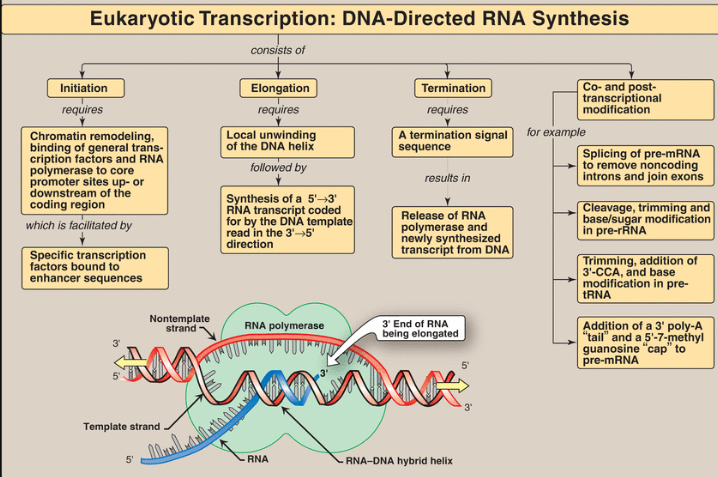Transcription
1. Preinitiation complex
-
An enzyme called RNA polymerase binds to a specific region of DNA called the promoter, located at the beginning of a gene.
RNA polymerase II is composed of 12 subunits and is the target of regulation by multiple transcription factors that specify which genes are transcribed.
The promoter is the binding site for transcription factors that form a preinitiation complex (PIC).
Transcription factors help RNA polymerase recognize the promoter and begin transcription.
RNA polymerase II does not bind directly to the promoter sequence but to the PIC. Enhancer sequences can, when bound, also modify the rate of initiation complex formation. The rate of transcription is controlled by the stability of the complex, which can dissociate easily from the promoter.
-
DNA is used as a template to create a messenger RNA (mRNA) molecule.
-
This occurs in the nucleus.
The initiation site of a gene is the specific location where transcription begins—in other words, where RNA polymerase starts synthesizing RNA based on the DNA template. This site is also known as the:
-
Transcription start site (TSS)
Key points about the initiation site:
-
It is usually designated as +1 on the DNA sequence.
-
It is located downstream of the promoter region, which is the sequence RNA polymerase and transcription factors bind to in order to initiate transcription.
-
The initiation site marks the first nucleotide that is transcribed into RNA.
-
In eukaryotes, it's often located just after the TATA box (a common promoter sequence), although the exact position varies between genes.
In summary:
The initiation site (or transcription start site) is the first base of the gene that gets transcribed into RNA, and it plays a central role in gene expression.
Content 3
-
-
The initiation site of a gene is the specific location where transcription begins—in other words, where RNA polymerase starts synthesizing RNA based on the DNA template. This site is also known as the:
-
Transcription start site (TSS)
Key points about the initiation site:
-
It is usually designated as +1 on the DNA sequence.
-
It is located downstream of the promoter region, which is the sequence RNA polymerase and transcription factors bind to in order to initiate transcription.
-
The initiation site marks the first nucleotide that is transcribed into RNA.
-
In eukaryotes, it's often located just after the TATA box (a common promoter sequence), although the exact position varies between genes.
In summary:
The initiation site (or transcription start site) is the first base of the gene that gets transcribed into RNA, and it plays a central role in gene expression.
-
-
2. Elongation:
-
RNA polymerase moves along the DNA template strand, unwinding the DNA and synthesizing a single-stranded RNA molecule.
-
It adds RNA nucleotides that are complementary to the DNA template (A pairs with U, C with G, etc.).
- Termination:
-
RNA polymerase continues until it reaches a termination signal in the DNA.
-
The RNA strand is released and is now called messenger RNA (mRNA) (in the case of protein-coding genes).
-
- RNA Splicing
-
mRNA splicing is the process by which non-coding regions (introns) are removed from a pre-mRNA transcript, and the coding regions (exons) are joined together to form a mature messenger RNA (mRNA) molecule. This happens in eukaryotic cells before the mRNA is exported from the nucleus for translation.
What mRNA Splicing Accomplishes:
-
Removes Introns:
-
Introns are non-functional sequences that do not code for proteins. Splicing removes them so the mRNA can be correctly translated.
-
-
Creates a Continuous Coding Sequence:
-
Exons are stitched together to form a proper, continuous coding sequence for the ribosome to read.
-
-
Enables Alternative Splicing:
-
The same gene can be spliced in different ways to produce multiple proteins (isoforms) from a single gene. This greatly increases protein diversity.
-
-
Prepares mRNA for Export and Translation:
-
Splicing is part of the overall maturation of mRNA, which includes adding a 5′ cap and a poly-A tail. Only mature mRNA is exported to the cytoplasm for translation.
-
In short, mRNA splicing ensures the genetic message is accurate and versatile, and it's essential for proper gene expression in eukaryotic organisms.
-
- ++++++++++++++++++++++
-
The initial RNA transcript (pre-mRNA) is spliced (introns removed, exons joined).
-
A 5' cap and a poly-A tail addition at the 3' end to protect the mRNA and aid in translation.
-
-
Splicing to remove non-coding sequences (introns) and join coding sequences (exons)
-
-
-
-
-
-
-
Key Steps in Gene Transcription:
-
Initiation:
-
An enzyme called RNA polymerase binds to a specific region of DNA called the promoter, located at the beginning of a gene.
-
Transcription factors help RNA polymerase recognize the promoter and begin transcription.
-
- Elongation:
-
RNA polymerase moves along the DNA template strand, unwinding the DNA and synthesizing a single-stranded RNA molecule.
-
It adds RNA nucleotides that are complementary to the DNA template (A pairs with U, C with G, etc.).
-
Result:
The mature mRNA exits the nucleus and travels to the ribosome, where it guides translation — the next step in protein synthesis.
